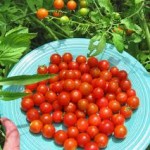August Gardening – Wally Richards
It has been a mild winter for many areas of New Zealand and it looks like an early spring is taking place. Don’t be fooled into thinking all is well as a cold snap can change things very quickly.
Last year around this time a number of gardeners got caught planting out tomatoes and other plants too soon. Miserable weather along with chilling winds not only destroyed early plantings but even plantings right up to December suffered.
Those gardeners with glasshouses were far better off and as I had to relocate during last spring I didn’t have my glasshouses operational till later in the season. This year I am well prepared with glasshouses ready to take plantings of early tomatoes, cucumbers, egg plants and capsicums.
I was happy to see that the first tomato plants had arrived in garden centres as I have been too busy to sow any seeds as planned.
I chose 3 types, Russian Red which is a favourite of mine for planting in large containers. It’s a dwarf variety which you don’t need to remove laterals, and it produces a medium sized fruit. It’s also hardier for cooler times. Grosse Lisse is a beefsteak tomato and given good tomato food will produce large fruit ideal to grow on now for planting out later. The other type I decided to grow at this time is Sweet 100 because it will quickly mature and produce ripe fruit early. I am sick of the tasteless commercial ones.
- Sweet 100
- Russia Red
- Grosse Lisse
Glass houses or cheap lean-to’s give provide a great head start.
Having a glasshouse or similar early in the season is a must for gardeners that require an early start.
If you don’t have a glasshouse and you are a handy person you could knock up a lean-to using 50 x 50 timber. Make it about a metre wide with the high side about 2 metres and the lower side about 1.8 metres. Place against a sunny wall and secure it against wind. Cover with plastic film leaving one end open. The open end should be away from your prevailing wind and sheltered, therefore no need for a door. A shelf about 20cm wide should be placed on the 1.8 metre side about a metre from the base. This is ideal for seedlings in punnets to germinate and grow on in small pots.
The 2 metre side is where you can have you larger pots with the tall growing plants in them.
The length you make the frame will depend on your needs for room and the space available.
Likely it should be about 2 metres or more in length.
If you are keen and in a good financial position to afford to, you can buy an aluminium kit set glasshouse or lean-to. They are more permanent and last most people a life time if looked after.
You can pay a couple of thousand dollars or about $100 build a lean to as described which will give you a few years with maybe having to replace the plastic film every so often.
To attach the film, use slats of thin wood nailed or stapled to the frame. You can’t staple directly through the film as it will damage quickly in winds.
Back to our new seasons tomato plants; I just love the smell of new tomato plants at the beginning of the season, it tells of promised crops to come. Take the young plants and pot them individually into small pots about 6cm wide and 10cm deep if not already in similar pots when purchased.
Use compost; (not potting mix) place sufficient compost to fill the bottom third of the pot then sprinkle a few grains of Neem Tree Granules and a little animal manure or a couple of sheep manure pellets. Cover with a little more compost and plant the tomato seedling deep up to its first set of leaves. The Neem Granules is to give initial protection from insect pests and by planting deep the tomato will root all the way up the trunk giving you a stronger plant because of a greater root system.
Finish off with sprinkling a little of my Secret Tomato Food with Neem Tree Granules on surface of medium. When your tomato has grown and filled the pot, then you transplant into a bigger container say about 16 to 20 cm wide. Repeat the process as above supplying more Neem and greater amounts of the foods. Also apply a stake for support and its a good idea to tie a Sticky White Fly Trap to the stake so any adult whitefly or psyllids flying in to lay eggs may be attracted and stuck.
Once the plant has filled this container its likely to be about half a metre tall or more and ready for a bigger container such as 20 to 50 litres or for planting out. It is important to stake the plant as it get taller so it will be easier to handle when re-potting.
Spray thoroughly with Vaporgard a couple of days before transplanting will do two things, harden up the plant for outdoors and also protect it further from pest insects.
Ensure that the plant has Neem Tree Granules in the planting hole and Tomato Food with Neem on the surface of the growing medium when transplanting.
The following are some spray combinations that are safe to use and free of harmful chemicals.
For disease problems make up a spray using 5mls of Liquid Copper into a litre of water, 12.5 mls of Liquid Sulphur into a separate litre of water, add 5 mils of Raingard to 3 litres of warm water along with 20 mls of Perkfection then combine all together to spray over tomatoes, roses and other plants.
Make sure that the Liquid Copper you use is blue in colour as its is pure Copper Hydroxide the one that is considered organic. (There is another one recently available which is not pure Copper Hydroxide and much more expensive making up only 60 odd litres of spray) The true one makes 250 litre or 500 litres dependant on the 250 ml or 500 ml bottle)
If you don’t use all the spray place surplus in a container so you can wash out sprayer and store in a dark place, Shake well before reusing.
For Insect control and plant health place per litre of warm water; 15 ml of Neem Tree oil, 10 ml of Magic Botanic Liquid (MBL) and 5 ml of Mycorrcin. If there are no insect problems leave out the Neem Tree Oil and the remaining two natural products can be used as they are or added safely to the disease control spray. Please note Neem Oil cannot be used with the disease control spray as it would react with sulphur and copper.
The above sprays are ideal for any garden plants and the MBL plus Mycorrcin especially good for strawberries and other food crops.




